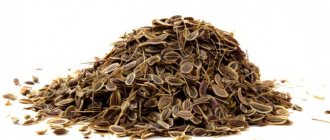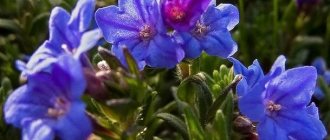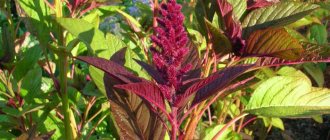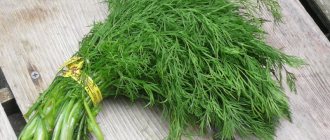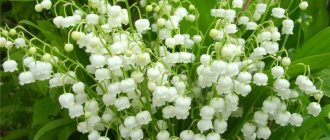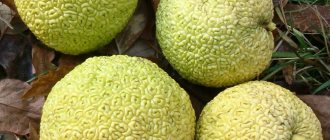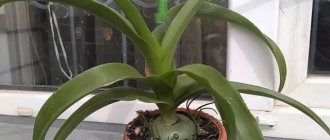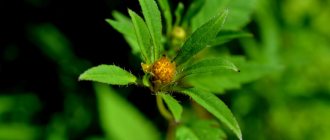Golden stars of flowers on bright green creeping vines are the loosestrife, beloved by the villagers of medieval Rus'. It was this plant that was brewed as a tea drink before Tsar Mikhail Fedorovich received real tea leaves as a gift from Chinese ambassadors. This article will tell you about the reasons for the popularity of loosestrife, its use in folk medicine and landscape design, and offer the most effective recipes for tea from this plant.
Loosestrife photo
Loosestrife - description of the plant
The most noticeable morphological feature of this perennial herbaceous plant is its long creeping shoots, dotted with “ears” - paired opposite leaves. These leaves are almost round, for which the plant received the name “coin loosestrife” (the spelling “coin loosestrife” is allowed).
Its Latin name is Lysimachia nummularia. The loosestrife received its generic name lysimachia in honor of Lysimachus, one of the military leaders of Alexander the Great, who, according to legend, first found it. The specific name is derived from the word “coin” - “nummulus”. And among the people the plant is known under the names meadow tea, penny grass, nibbles, lawn grass. For its ability to quickly capture territory, loosestrife received the nickname “snake root.”
The stems of meadow tea reach a length of 50-60 cm. They are light green, almost yellow, and are clearly visible in the foliage. From a distance it seems that these are skewers for canapés, studded with pieces of kiwi fruit. They lie on the ground, spreading in all directions from the center, and if the plant is rooted on a cliff, they hang picturesquely from it.
For a more complete botanical description, it is important to note that:
- stems, leaves and even petals are dotted with small dark glands;
- the flowers are axillary, on long stalks, covering the middle part of the shoot;
- the plant is well adapted to wintering along with the leaves.
Loosestrife is self-sterile and generally does not reproduce well by seed. This must be taken into account when growing it in garden plots and when preparing medicinal raw materials.
Long creeping shoots are a feature of the loosestrife
Methods of preparation and use
For medicinal purposes, you can use the green leaves of loosestrife and its roots. Traditional medicine offers several ways to process plant materials.
Infusion
A water infusion of common loosestrife is good for anemia, scurvy and chronic constipation. The product is prepared according to the following algorithm:
- pour two large spoons of dry leaves of the plant into a thermos;
- pour 500 ml of boiling water over the raw materials;
- cover with a lid and leave for an hour;
- filter.
We recommend reading: The health benefits and harms of Sicilian (red) oranges
You need to take a large spoon three times a day.
Loosestrife infusion removes phlegm from coughs and bronchitis
Decoction
For weakened immunity and frequent migraines, it is useful to prepare a healing decoction of common loosestrife. The recipe looks like this:
- 40 g of medicinal raw materials are crushed and poured with 400 ml of boiling water;
- process in a water bath for half an hour;
- remove and cool until warm;
- filter through cheesecloth.
You need to take 100 ml of the decoction twice a day, in the morning before breakfast and in the evening before dinner.
A decoction of common loosestrife is suitable for compresses for bruises and rheumatism.
Tincture
For chronic fatigue, loss of strength and anemia due to serious illness, you can take tincture of common loosestrife. It is prepared like this:
- two large spoons of fresh leaves are poured with 200 ml of vodka;
- close the vessel and put it in a closet for a week;
- removed from time to time to shake it up;
- filter.
The finished product is drunk up to four times a day, 15-20 drops.
Tincture of common loosestrife can be used to wipe cuts and abrasions for disinfection.
Chemical composition of loosestrife
The biochemical side of loosestrife has been studied quite well. Our ancestors intuitively sensed a rich list of biologically active substances in meadow loosestrife tea:
- the neurotransmitter acetylcholine and its precursor choline;
- rutin and other glycosides with P-vitamin activity;
- fatty oils abundantly secreted by glands;
- caffeic and other organic acids;
- vitamin C.
Loosestrife is completely non-toxic; it can be included in green fodder and hay for farm animals.
Where does loosestrife grow?
Meadow tea is a typical inhabitant of Europe. In Russia, it is distributed from the North Caucasus to the Kola Peninsula and from the Kaliningrad region to the Altai Territory. To the east of the Yenisei it occurs in single specimens as an alien plant.
Wild loosestrife grows everywhere, but it forms more lush clumps in low relief areas, where there is a little less sun and a little more water. Prefers floodplain meadows, small ravines, banks of ponds and swamps. Cultivated forms require little shading.
Use of loosestrife
This medicinal plant is used only in folk medicine. Its main use is to prevent scurvy in winter. In remote villages, loosestrife leaves are still brewed as a tonic tea.
There are other ways to benefit from penny herb:
- fresh juice stops minor bleeding;
- compresses are soaked in the decoction for applying to wounds and eczema;
- infusion treats cough with copious sputum, gout, thrush;
- A paste of fresh leaves relieves pain and swelling from cuts, bruises, and damaged ligaments.
In Eastern European countries, lysimachia is recommended for facial skin care for acne and acne, and for rinsing hair with excessive dandruff formation. Veterinarians use dried root powder to clean fly larvae from animal wounds.
The plant is used only in folk medicine
How to assemble
Collected when it blooms. At this time, useful substances are concentrated in the loosestrife in huge quantities. Dry in a shady place, out of direct sunlight, and store for a year.
At the same time as the above-ground part, the roots are collected. Dry with a dryer at temperatures up to fifty-five degrees. The roots of common loosestrife retain their beneficial properties for two years.
Juice squeezed from fresh loosestrife is suitable for use for two months if stored in a cool place. When frozen, it retains its properties for a year.
You may also be interested in: Veh poisonous - poison or benefit
Medicinal properties and possible harm of loosestrife
It has been experimentally shown that the substances that make up meadow tea have the following effects:
- hemostatic;
- antiviral;
- antibacterial.
Rutin in conjunction with vitamin C strengthens capillary walls and increases the overall level of immunity, which explains the beneficial effect of meadow tea on patients with colds. Loosestrife preparations normalize the composition of the blood, preventing its excessive “thinning.” In this regard, there are contraindications for the use of the plant - varicose veins, a tendency to thrombus formation, hypertension, sclerosis of the blood vessels of the extremities. Loosestrife is not recommended for dry cough.
How to plant and care for a plant
With the help of penny grass you can luxuriously decorate your garden plot. The plant has established itself in landscape design as an excellent ground cover for open ground. Drooping shoots decorate balconies, verandas, terraces, and creeping shoots cover the edges of garden paths and the ground around solitaire plantings.
Loosestrife looks impressive along the banks of artificial reservoirs, on the shaded slopes of alpine hills. In temperate zones and to the north, meadow tea grows well in the sun. Gardeners appreciate the original Aurea variety with light, almost golden leaves.
Loosestrife is propagated by rooting cuttings at any time of the growing season. They don’t even need to be treated with root formation stimulants—moist soil is enough. In the fall, you can divide an adult bush. Delenki take root well in well-moistened soil without bright lighting.
Planting and care for loosestrife are quite simple:
- Any soil is suitable for the plant, except clean sand and heavy loam;
- fertilizers are needed only on initially poor soil - peat mulch will do;
- watering is required only during drought;
- In autumn or early spring, thickets require clearing of dried shoots.
When loosening the soil, excess loosestrife roots are mercilessly cut off with a shovel, otherwise the plant begins to behave like a weed and may even “crawl” to its neighbors. This invader is planted along the edge of the site only if there is a road behind the fence or a wasteland begins. It is not recommended to plant a lawn with meadow tea, since by autumn some of its leaves dry out and spoil the appearance of the lawn.
Decorating a garden plot with loosestrife
Cultivation and propagation techniques
Without any difficulties, the plant reproduces vegetatively. It is also possible to grow a bush from seeds.
Use of multicellular structure
Growing a new plant using a multicellular structure requires effort. But for successful seed germination, you must follow these recommendations:
Before planting the seed, it is hardened. The multicellular structure is placed in a basement or refrigerator for a month and a half; it is advisable to choose a compartment for vegetables. The laying takes place in early May.
If sowing is planned for autumn, the seeds do not need to be hardened, because they will already fit in cold soil. With the arrival of the first warm days, sunrises will begin to grow in groups.
In the same way, you can plant a multicellular structure on seedlings. Only hardened seeds are used and sown in moist soil. Its composition should include river sand and loose sedimentary rock. After sowing, the sprout is covered with a plastic or glass bottle.
Popular: Bush-shaped tolmia for carpet decoration of home or garden
It is important to ensure the desired air temperature; it is advisable to keep it at least 15 degrees. After two weeks, the first shoots will appear above the ground.
When the sprouts become strong, they are transplanted into small pots (plastic glasses can be used). At the beginning or middle of summer, planting occurs in open ground. The distance between sprouts is up to 50 centimeters. The first inflorescences appear only in the third year.
Collection, preparation and storage of loosestrife
In folk medicine, loosestrife is used entirely: with roots and shoots. Harvesting is carried out during flowering - from May to August, since at this time meadow tea accumulates a maximum of vitamin C. The bushes are dug up with a spatula (pulled out from sandy loam soil), carefully shaken off lumps of earth and dried in the shade under a canopy. Store raw materials in paper bags in a dry place.
Since the plant is collected from the roots, when harvesting wild raw materials, it is necessary to leave several specimens to renew the population.
Variety of varieties
Gardeners use several types of coin meadow tea - Aurea and Goldilox. The first type refers to a variety with recumbent shoots, where rounded and rather decorative foliage of a light green color is located opposite. Inflorescences appear no earlier than mid-summer, and if there is insufficient light, fiery buds will appear by the end of August.
The species is distinguished by its endurance. It perfectly withstands temporary drought and at the same time the roots will not rot during prolonged rains. Its shoots are resistant to sub-zero temperatures, and the stem quickly recovers from mechanical damage.
The Goldilox variety stands out for its characteristics. The variety tolerates moderate drought and humidity well. The plant develops on rocky soil. However, it is better to replant it in more comfortable soil - porous soil with organic impurities.
Popular: Decorative Duchesnea strawberries for decorating gardens and flowerpots
The species has unusual greenery with a golden hue. To maintain this decorative effect, the plant requires a lot of light. In the shade it will lose its characteristics. The inflorescences of this species are sunny-colored and their size is several times larger than the leaves. The species reproduces quickly and can immediately outgrow the remaining inhabitants of the flowerbed.

